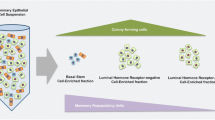Abstract
Physiological cell turnover plays an important role in maintaining normal tissue function and architecture. This is achieved by the dynamic balance of cellular regeneration and elimination, occurring periodically in tissues such as the uterus and mammary gland, or at constant rates in tissues such as the gastrointestinal tract and adipose tissue. Apoptosis has been identified as the prevalent mode of physiological cell loss in most tissues. Cell turnover is precisely regulated by the interplay of various endocrine and paracrine factors, which modulate tissue and cell-specific responses on proliferation and apoptosis, either directly, or by altering expression and function of key cell proliferative and/or death genes. Although recent studies have provided significant information on specific tissue systems, a clearly defined pathway that mediates cell turnover has not yet emerged for any tissue. Several similarities exist among the various tissues with regard to the intermediates that regulate tissue homeostasis, enabling a better understanding of the general mechanisms involved in the process. Here we review the mechanisms by which hormonal and cytokine factors mediate cell turnover in various tissues, emphasizing common themes and tissue-specific differences.
Similar content being viewed by others
Author information
Authors and Affiliations
Additional information
Electronic Publication
Rights and permissions
About this article
Cite this article
Medh, R., Thompson, E. Hormonal regulation of physiological cell turnover and apoptosis. Cell Tissue Res 301, 101–124 (2000). https://doi.org/10.1007/s004419900159
Received:
Accepted:
Published:
Issue Date:
DOI: https://doi.org/10.1007/s004419900159




